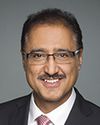Thank you so much, Madam Chair.
I have a bit of a sore throat, so I hope you can understand me.
I've been asked to appear today to speak about Infrastructure Canada's main estimates and what my department is doing to deliver on the government's commitment to invest in Canadian communities through its long-term infrastructure plan, called “investing in Canada”.
Madam Chair, you introduced some of my staff members. I'm also joined by Glenn Campbell, executive director of the Canada infrastructure bank transition office, as well as my parliamentary secretary, Marc Miller.
Colleagues, the Government of Canada has an ambitious plan and vision for infrastructure funding in Canada.
We have been making great progress in delivering projects. Since November 2015, we have approved over 2,200 projects across the country, with a total value of $20 billion. These projects are now rolling out in communities large and small.
These investments are making real, tangible impacts in Canadian communities. This means that 864 public transit projects have been approved to date, including over 200 projects that will make public transit more accessible for people with disabilities. The investments made will expand 132 transit systems across the country and help communities acquire more than 1,000 new buses, among other improvements. Together, these investments will deliver faster, more reliable service, and will help reduce traffic congestion and pollution.
To date, 908 projects under the clean water and wastewater fund have been approved. These investments will give more Canadians access to clean drinking water and will reduce pollution in our lakes and rivers.
Over 2,000 projects to retrofit or renovate social housing have been approved to date, helping improve energy and water efficiency in almost 90,000 existing social housing units.
There are 182 arts and heritage facilities in 109 communities that are being improved.
Nearly 6,000 housing units on reserve have been built, renovated, or planned, along with 125 projects aimed at building and improving schools.
There are 251 projects under the post-secondary institutions investment fund that are under way to enhance and modernize research and commercialization facilities on Canadian campuses.
With budget 2017, we have formalized the commitment we made through the fall economic statement. The budget showed how we will invest more than $180 billion in federal funding over 12 years. It showed how these investments will create long-term economic growth; build inclusive, sustainable communities; and support a low-carbon, green economy.
Our plan focuses on five key areas: public transit; green infrastructure; social infrastructure; trade and transportation infrastructure; and rural and northern communities infrastructure. It also features two new initiatives, the smart cities challenge and the Canada infrastructure bank.
The Canada infrastructure bank will be responsible for investing at least $35 billion over 11 years, using loans, loan guarantees, and equity investments, and attracting private capital for public infrastructure. The bank's funds will be over and above the commitment we made to double infrastructure funding. Most importantly, it will offer our funding partners a new way to help meet their pressing infrastructure needs.
The second initiative I mentioned is the smart cities challenge.
It is vital that our communities are at their best, that they be responsive to the needs of citizens and be nimble in adapting to the increasingly complex challenges they face. Smart cities will do this by being better connected to their citizens, by using data to make decisions that impact quality of life, by helping to drive and attract innovation, and by fostering positive change in our communities through social inclusion.
Budget 2017 announced $300 million for the smart cities challenge to “encourage cities to adopt new and innovative approaches to city-building” by focusing on innovative, measurable, and outcomes-based solutions. And most importantly, it will be delivered it in full partnership with all sectors of Canadian society while drawing on similar experiences in the United States, India, and other countries. We will be sharing more detailed information about the smart cities challenge in the coming weeks and months.
I would now like to address the department's main estimates and speak briefly about how our funding flows to our partners.
Infrastructure Canada's total authorities for the new fiscal year are $7 billion, which is up $3.1 billion dollars from what was requested last year. On that note, the authorities in the main estimates do not include funding for the new phase of our program, but they do include nearly $2.7 billion in contribution funding for the public transit infrastructure fund and the clean water and wastewater fund. It is through these two programs that we have announced over 1,760 projects to date.
At my previous appearance, some of you raised concerns about funds flowing to projects across the country. It is important to note, however, that Infrastructure Canada's funding matches the pace at which our partners submit claims for reimbursements. Most partners submit claims throughout the life of the project, although some wait until the project has been completed. When projects are approved, funding is available for reimbursement even if projects are delayed or funds are not spent as forecast.
Through budget 2017, the Government of Canada is showing how it will support Canadian communities in the years to come. Infrastructure has a great many challenge ahead of us. We are ready to meet them and to support other communities to build the infrastructure they need.
Thank you, Madam Chair.






